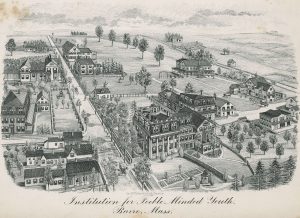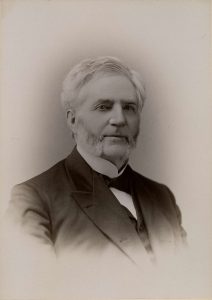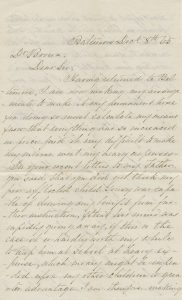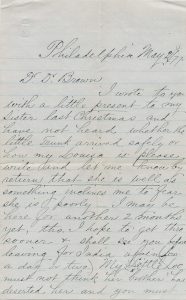By Susan Martin, Processing Archivist & EAD Coordinator

The Elm Hill Private School and Home for the Education of Feeble-Minded Youth in Barre, Mass. was the first school of its kind in the United States. It was founded in 1848 by Dr. Hervey B. Wilbur, and Dr. George Brown took over as superintendent three years later. The MHS holds a small collection of George Brown papers, including correspondence, financial documents, and printed items related to this ground-breaking school. Here’s a picture of Dr. Brown from the George Brown family photographs.

A promotional broadside from 1864 declared that the Elm Hill School “offers the best educational advantages for children and youth, whose different phases of mental infirmity unfit them for receiving instruction by the ordinary methods, and at the same time provides a permanent home for those who desire it, where every comfort which wealth can procure is furnished.” Of course, only families with means could afford to send their children to this exclusive and remote private institution, and some students came a long way to attend.
The collection includes a few folders of letters from students’ family members, and these can be mined for some tantalizing details. For example, one 1865 letter relates to Elm Hill student Gouverneur Heiskell. Gouvy, as his family called him, was born in 1847 or 1848, and his great-grandfather was none other than President James Monroe. After the Civil War, Gouvy’s family found itself in tough financial circumstances, so his mother wrote to Dr. Brown.

In your recent letters to my Father you said that you did not think my poor afflicted child Gouvy was capable of deriving any benefit from further instruction, & that his mind was rapidly giving away, if this is the case it is hardly worth my while to keep him at school at heavy expense, which money might be expended upon my other children to greater advantage. I am therefore making every effort to find some respectable family living in the country who would be glad to take him for a moderate sum, & take care of him treating him kindly & giving him good food & lodging. I find myself in a fair way of doing this in some German families, but before they make any arrangements they require a statement of his case, that is if he is harmless easily managed &c &c […] I never shall forget yours & Mrs Browns kindness & shall always number you among my friends […] I should like very much to have a Photograph of Gouvy.
One particularly interesting story is that of the Kollock family. Charles Kollock was an Elm Hill student from a large Philadelphia family. His father, Rev. Shepard Kosciusko Kollock, died in 1865, leaving his children $14,000 in ready money. At that time, the reverend’s oldest son Matthew was serving with the army in California, so brother John agreed to act as estate administrator. However, by late 1867, the family’s account with Elm Hill was in serious arrears, and John wrote anxiously to Dr. Brown that he was having trouble coming up with the money.
I am aware, that your patience with me, is well nigh exhausted, and that you feel that you cannot keep my brother any longer unless your bills are paid. I have been trying very hard to get Charles’ money in such a shape, that there will be no further difficulty […] It is the desire of all my family, as well as myself, that Charles should remain with you, if you will keep him.
Eventually oldest brother Matthew, somewhat confused, contacted Dr. Brown directly.
I have heard nothing from my brother Charles for more than two years, and feel anxious to hear from you direct, how he is, and also whether his board and tuition is paid promptly, when it is due by my brother John. I do not like to ask him questions about it as he seems to dislike to answer them.
Dr. Brown replied immediately, and just five days later Matthew wrote again, “astonished” to hear about the unpaid debt amounting to hundreds of dollars. He explained that fully $4,000 of their father’s $14,000 had been designated for Charles’ support, and he suspected that John had lost the entire sum in “rash speculations.”

Matthew asked Dr. Brown to send him the outstanding bills and resolved to bring a case against his brother for “breach of trust.” He also called John out for lying about an army appointment. Eventually sister Mary reached out to other relatives, who helped with Charles’ expenses.
James Reynell, an India merchant, also lived in Philadelphia, and his sister attended the Elm Hill School. Here’s an excerpt of an 1877 letter to Dr. Brown.

I wrote to you with a little present to my Sister last Christmas and have not heard whether the little Trunk arrived safely or how my Louisa is. Please write and let me know by return that she is well as something inclines me to fear she is poorly. […] My Little Loo must not think her brother has deserted her and you must kindly keep me in her memory even if I do not write so often as I ought. Please tell her I send kisses & love […]
The Elm Hill School was known by many names over time, reflecting the evolution of its mission and probably changing sensibilities. Some of Elm Hill’s previous (and very unfortunate) names included the Institution for the Education of Idiots, Imbeciles, and Children of Retarded Development of Mind (ca. 1851) and the Private Institution for the Education of Idiots, Imbeciles, and Backward and Eccentric Children (ca. 1853-1855). “Imbecile” was dropped sometime after 1858, and “Children” became “Youth” before 1870.
George Brown superintended the school for 40 years, until his death in 1892. At that time, though other schools for the “feeble-minded” had since been established, Elm Hill was the largest private institution of its kind in the country. Dr. Brown’s son George Artemas Brown succeeded him as superintendent, followed by his son George Percy Brown. The institution closed in 1946, 98 years after its founding.
The George Brown papers fill only one document box, and these letters represent just a fraction of Dr. Brown’s overall correspondence. They give us a fascinating glimpse into his work in Barre, but tell us very little about the students themselves or their education. Interested researchers will find additional material in a collection of Elm Hill School records at the Historical Medical Library of the College of Physicians of Philadelphia. That library also holds some Brown family papers, primarily those of later generations.

